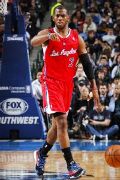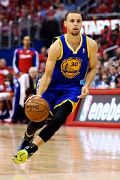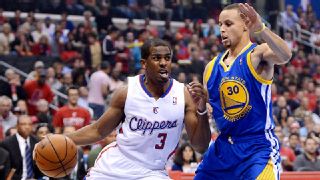|
“Point guard” evokes a certain kind of romance that other positions on the basketball floor don’t hold. Even if the league’s two best players are “small forwards,” the “SF” designation doesn’t mean as much to people. The point guard is the floor general, the quarterback, the engine of the offense, the head of the snake. Perhaps the idea of a team’s smallest player as its offensive fulcrum is outdated, but it endures. Equally enduring is the idea that there’s a “right way” to be a point guard. “He’s a pure point guard” gets said a lot more often than “he’s a pure power forward,” for instance. Chris Paul and Stephen Curry may be the league’s two best at the position, and the Clippers-Warriors series could serve as a contest in whose style is paramount. Paul is the archetypal floor general, heir to a rich tradition of how to run a team. Curry is something different, something new. While Paul attacks defenses “the right way,” Curry’s distance shooting bends defenses in ways we haven’t seen before. Let us establish their similarities, though. Each hails from North Carolina and played college ball at a private school in his home state. Each claims excellent vision and an exquisite handle. On the face of it, these are similar players. Their differences are stark, though, and are probably rooted in personality traits that can manifest on the court.
CP3: The ControllerAfter a loss in Game 1 against the Warriors, Doc Rivers was asked about the status of Paul. “Typical Chris,” Rivers said. “Very hard on himself as usual. Very focused. I don’t know well in that, but I’m learning as this year goes on that if he has a game he didn't like, he gets real hard on himself. And I don’t always know if I like that or not yet, to be honest. That’s something I’ll have to find out.” Earlier in the season, after going 5-of-15 against the Warriors, Paul engaged in a lengthy late-night shooting practice on the Staples Center floor. This was after a game the Clippers won handily.  It’s no surprise Paul’s haunted by failure, as he’s so detail-oriented about success. He’s famously competitive and a total control freak in manner. He constantly works the refs throughout a game, and lobbies with a viciousness that a taller man couldn’t pull off. It’s no surprise Paul’s haunted by failure, as he’s so detail-oriented about success. He’s famously competitive and a total control freak in manner. He constantly works the refs throughout a game, and lobbies with a viciousness that a taller man couldn’t pull off.
Every edge must be leveraged, every market inefficiency must be exploited. The head whips back when the defender makes contact, lest the ref ignore the foul. Those 2-for-1 opportunities are all getting used, as though Paul is accumulating frequent flier miles with each of them. He’s a coupon-clipping point guard, always seeking to save what less committed men might squander. The refs aren’t the only recipients of his competitive fury. Coworkers get an earful, too. “I swear I hate a dude who get there, and feel like they done made it,” Paul once groused of an unnamed slacker teammate. He isn’t lying in telling younger players, “When I step out on the court, Bron, Melo, D-Wade, they know not to take the ball from me.” Some defenders would sooner reach into an active garbage disposal than reach in for a steal on CP3. His hands are too strong, too quick. He also doesn’t panic. Defenders try to hound their marks into “speeding up,” but Paul refuses to hurry. The little man sticks his butt out, widens his stance, occupies as much space as possible. You adjust to him, not the other way around. When defenders chase after him, he’ll delight in slowing down to bludgeon them with his backside, or draw contact for the foul. Knowing full well he has total control of the ball, Paul operates at his own pace, probing the defense until it falters. If he’s the quarterback of an offense, he’s Peyton Manning -- obsessively studious in the impossible pursuit of perfection. The study leads to minimized risk, meaning fewer interceptions or, in Paul’s case, turnovers. Like Manning, Paul’s greatest strength -- that tight control -- might be his greatest weakness. Similar to how the Denver quarterback has been criticized for ignoring his running backs, the ball can stick in Paul’s hands at times. While Paul tends to end possessions with brilliant passes, he can phase teammates out during the search. On balance, though, Paul’s method produces results. It’s also worth noting that he’s ceded a measure of control to Blake Griffin's creative powers this season. It should also be noted that some Paul passes are more triumphs of imagination than feats of problem-solving.
SC 30: In the FlowWhen asked about how he feels after a loss as rough as the Game 2 loss to the Clippers, Curry said, “Once I go home, I’m the same guy. I try not to let anything on the court affect anything at home and that kind of deal.” He later added, “I don’t go home and quarantine myself.” Curry is certainly competitive and, like Paul, has a renowned work ethic. But his approach is a bit more relaxed, perhaps more Zen. Laughter is the steady metronome of his shooting drills. He jokes and banters his way around the arc. His quest for perfection might be more about getting in tune with something than exerting control over it.  To David Fleming, Curry described: “I love everything about shooting, but mostly that perfect form, when your body is in rhythm from the time you plant your feet to the time you release the ball. When it happens, everything is very smooth and calm from your feet through your release. Everything moves through you like a wave, almost. It's a beautiful thing." To David Fleming, Curry described: “I love everything about shooting, but mostly that perfect form, when your body is in rhythm from the time you plant your feet to the time you release the ball. When it happens, everything is very smooth and calm from your feet through your release. Everything moves through you like a wave, almost. It's a beautiful thing."
Though he can’t claim a better handle than Paul, he certainly looks more comfortable out there. He’s more upright, preferring regular walking form to Paul’s jutted crouch. Only defenses are subject to Curry’s wrath. “If you don’t get along with Steph, then the problem is you, not Steph,” Mark Jackson said when asked if Curry ever chewed out a teammate. Refs are mostly free of Curry’s scorn, too. Whereas Paul collected 10 technical fouls this season, Curry went the whole season without one until Monday night’s blowout loss. “I would get very tired talking every possession, every play," Curry explained of his lack of lobbying. Perhaps it’d all be a distraction from the pursuit of that perfect shooting wave. If Curry has a quarterback comparison, then it’s Packers-era Brett Favre. As the Favre cliché went, Curry’s “just having fun out there.” He might pull up from 35 feet if the inspiration strikes, or he might, in full gait, zip a one-handed pass across the court. The bold decisions are animated by a whimsy that seems to insulate him from pressure. Perhaps his carefree style is born out of being a prodigy. Nobody can shoot like he can off the move. It may come so easily to him that the game seems less a quest for minute advantages and more a testing ground for a superior talent. Like Favre, Curry’s gunslinging style brings big risks and big rewards. This season, Curry leads all players in turnovers while also leading all in 3-pointers made. On the balance, he’s super efficient, but that efficiency comes with some horrific-looking giveaways. The gunslinger’s approach is most pronounced in Curry’s passing, where he’s doing some of the most daring work around the league. Two examples stick out, both from a tightly contested regular-season game against Memphis. Notice here how Curry throws Harrison Barnes open with a pass that whizzes between four Grizzlies. From the media row angle, it was difficult to see why the pass was going that particular trajectory until Barnes rose up for the dunk. To make this play, you can’t be playing scared. There’s more evidence of Curry’s “no fear” approach later in the game, when with less than a minute to go and a three-point lead, Curry threw a no-look over-the-shoulder pass to Jermaine O’Neal. At the time, the game was considered crucial in helping the Warriors get a playoff seed. The stakes didn’t dissuade Curry from going Harlem Globetrotters when inspiration struck. They ended up winning and Curry scored 33 points to go with eight assists.
The ChoiceIf you’re choosing between these two players for one game, you’re probably taking Paul. He’s marginally more efficient in his offensive output, and his defense is superior. Curry might find it difficult to prove his value in this series, as the Warriors are likely to struggle without the injured Andrew Bogut. That’s today, but Curry could well rule the future. He’s two years younger and he twists defenses in a way Paul does not. Right now, the Clippers are trapping Curry with everyone but the ball boy, for fear he’ll hit 3-pointers off the dribble. The Warriors are mostly playing Paul straight up with Klay Thompson. Curry’s singular ability to hit 3-pointers off the bounce represents a shift in what the position can be, and how it will get teammates open. Paul’s command and controlling style harken back to a past of great point guards getting in the lane and expertly micromanaging their teams to success. Curry’s free-wheeling, long-bombing style -- which you can see flashes of in the emerging Damian Lillard -- promises new space for offenses to explore. Paul is a “true point guard” today. Curry might be what a “true point guard” becomes.
|

